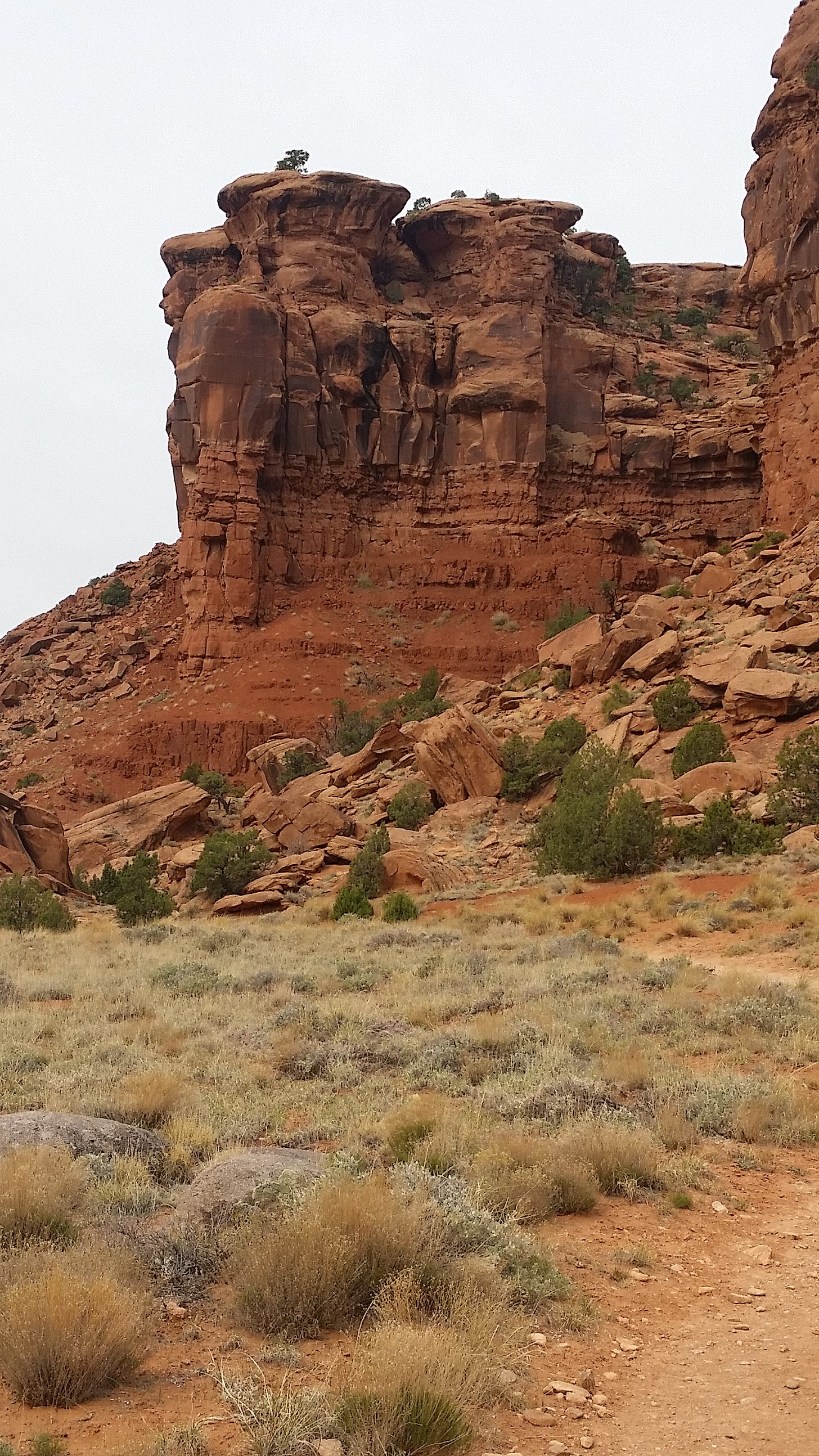Thanks for all the new subscribers and upgrades over the last month when I’ve been offering a discounted rate to celebrate two years of Taking Bearings. That continues through today, so take advantage if you want to become a paid subscriber for less.
Lately, I’ve kept myself mostly home-bound, despite my newsletter’s The Field Trip rotation being deliberately designed to get me out and about. Because of that, I’m time traveling again this week to share a hike from 2017 in Dominguez Canyon Wilderness. Read on!
Sojourn to Western Colorado
Even a job as flexible as a college professor’s makes it hard to travel for more than short trips (except in summer, of course). An exception during my academic career took me for three weeks to Colorado Mesa University in Grand Junction.
I enjoyed a visiting professorship where I was able to teach a one-credit class and deliver a public address (at which I encountered the most hostile questioner I have ever faced), while keeping up with my regular my home courses temporarily online. I still had time to explore the region surrounding Grand Junction.
I enjoyed every minute, able to visit several sites new to me: Arches and Canyonlands National Parks, Colorado National Monument, Grand Mesa, Uncompahgre Plateau, and Dominguez Canyon.
As my time in Grand Junction wound down, I headed for a little hike in the Dominguez Canyon Wilderness, knowing it was my last opportunity (on this visit) to experience Colorado’s backcountry up close and slow. The wilderness is part of the Dominguez - Escalante National Conservation Area, administered by the Bureau of Land Management, established with the big 2009 Omnibus Public Lands Management Act. (It’s good to know that at times big public lands legislation can still happen.)
Human Signs in Wilderness
After getting to the trailhead, a little jaunt along the railroad tracks is necessary to get into the wilderness. Across the Gunnison River, a ranch stretched beside a river bend. I headed the other direction, crossed a substantial bridge, and made my way along the western side of the Gunnison, now inside the wilderness boundary.
The Gunnison, brown in early April, slithers between red rock not as dramatic as some places but plenty pretty. It wasn’t long before I noticed irrigation works, old and falling down, a remnant of an earlier time when the water here was put to work for more local ranches.
The trail bent to follow a tributary, Big Dominguez Creek, and I stepped further into the designated wilderness, its heart, the canyon. A little diversion dam sat there, a kind of sentry to the interior part of the plateau. Then, a corral of sorts that incorporated big boulders invited me to consider those older pastoral roots of this place.
The canyon included brush and some grass, but my first idea seeing it was not, “This looks like a great place to graze my herds.” Perhaps that’s a sign that grasses had declined over previous decades of overgrazing — that certainly has been the case in many places — but I don’t know the specific land use here.
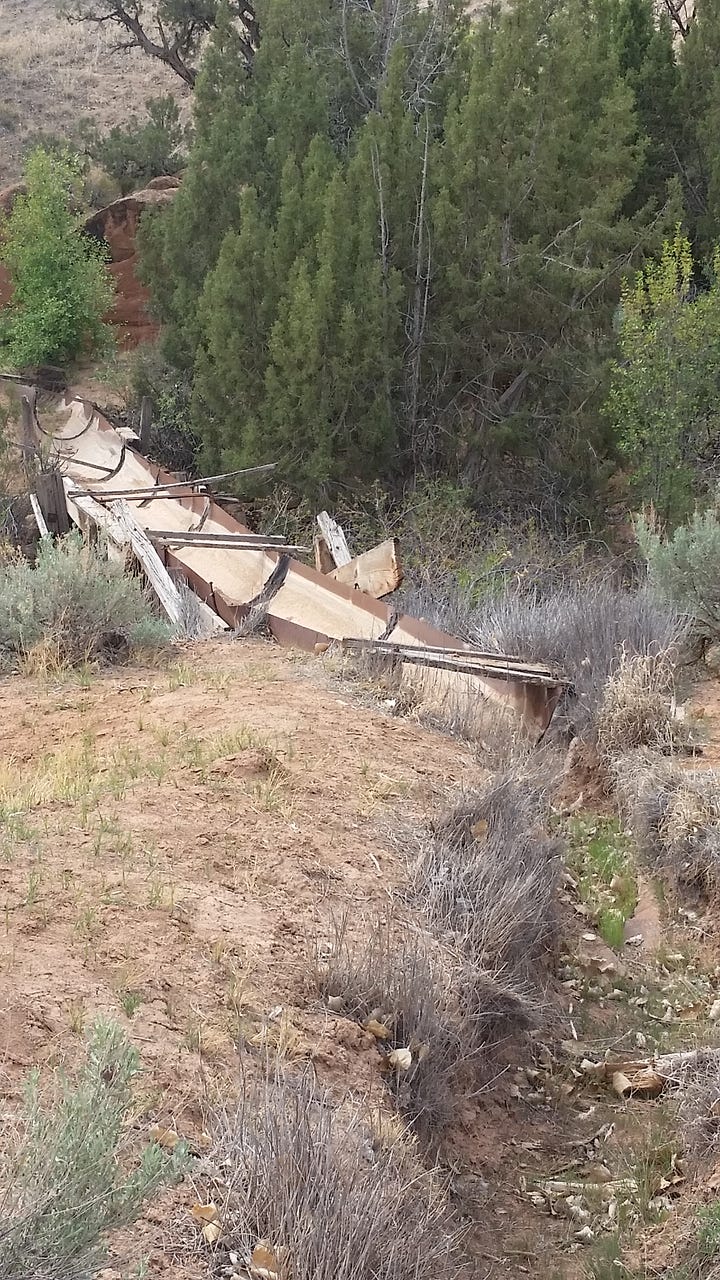
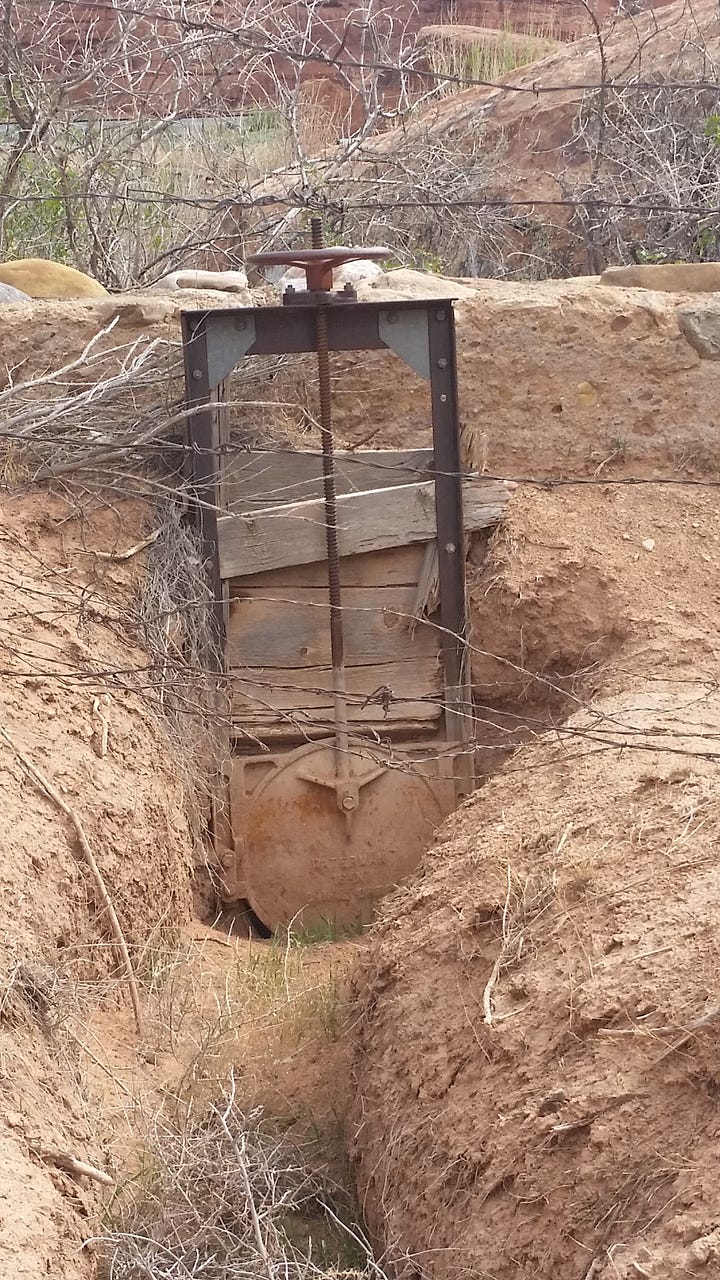
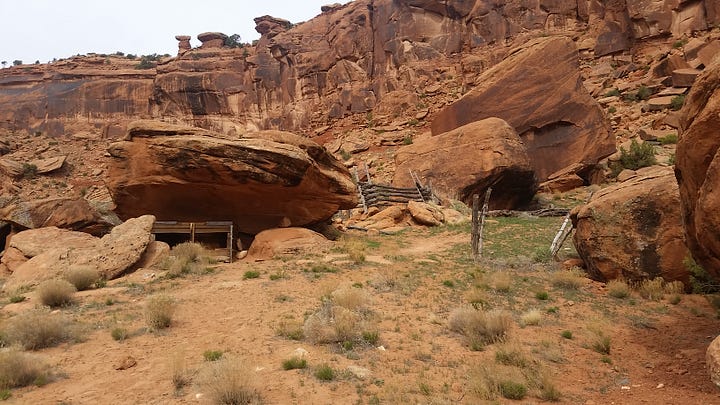
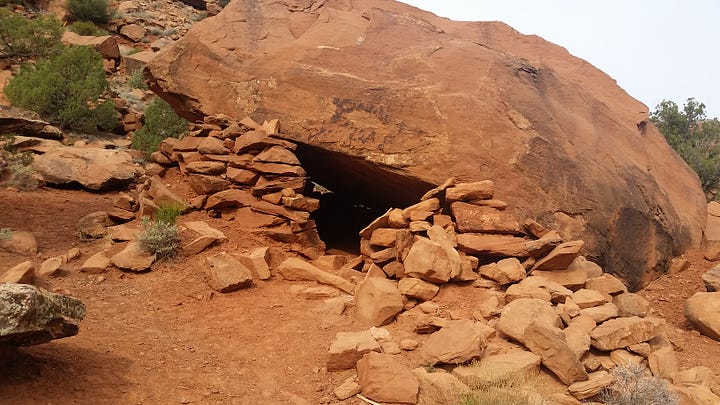
A short while later, moving through what felt a bit like a large amphitheater, I found the feature I’d read about: a house. Kind of. It’s a big rock, angled, with a foundation filled in with smaller rocks. Tiny, but it would have protected someone from some weather. Carved into the stone was “M. A. Wooley Built This House May the 18, 1901.” I climbed in and imagined passing time there, wondering what Wooley worried and dreamed about.
It is worth spending a minute pondering these apparent juxtapositions. At this point, I’d been hiking in designated wilderness for a couple miles and seen plenty of human artifacts. Sometimes people talk casually about wilderness being “untouched.” This is not the case, of course. Indigenous peoples called this continent home since time immemorial, and it is hard to imagine many places on the continent that were truly untouched by successive generations of these land and water stewards.
And cases like this one I was walking through in Colorado show that the touches happened much more recently too. Howard Zahniser, author of the Wilderness Act, used the word “untrammeled,” not untouched, in the law deliberately. I think the word untrammeled, if considered and used consciously, is a way through some (not all!) of the knotty problems of “wilderness.” Saying a place is “untouched” erases the people who were there; saying something is “unconfined” or “unimpeded” or “not bound up” says something different, less absolute, and, I think, more accurate about the past and more relevant now.
Recognizing the human history in these places, at least for me, enhances rather than detracts my experience being in wild, untrammeled spaces.
Around the Bends
I meant to see more than this rock house, so I kept on my way. I heard the sounds of Big Dominguez Creek and wandered toward it to eat my lunch. I find nothing more soothing or meditative than the sound of moving water, so this respite soothed and pleased me. A small drop in water cut through the rock, gray and quite dark here compared to the surrounding rust-tinged hills and soil.


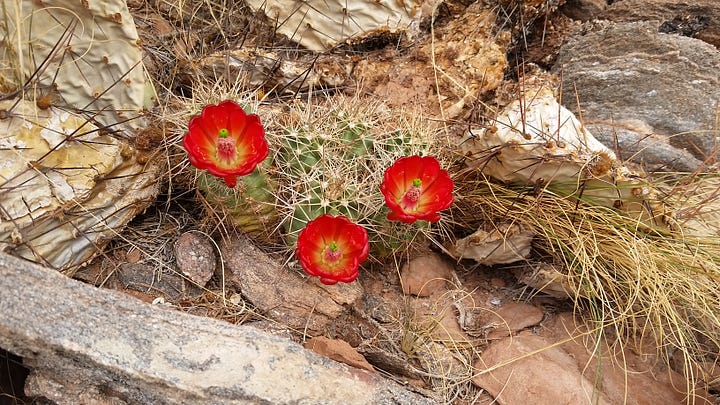
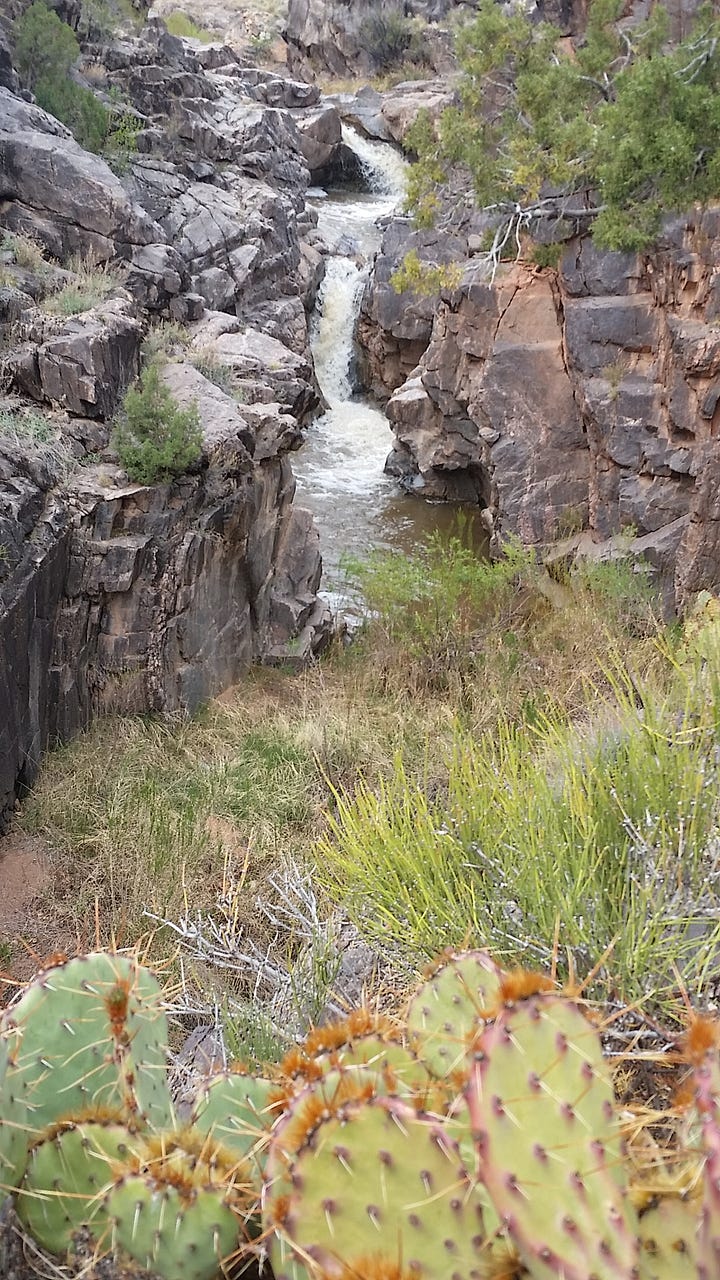
I kept on, not wanting to head back to my short-term rental in Grand Junction to attend to work.
I faced a dilemma you may have also experienced: when do you turn back? I was on the trail. It kept rising a little. It kept turning a little. And it seemed if I just made it to the next rise, the next bend, I would have a vista open to me so I could look across a wide part of the Uncompahgre Plateau. I kept going, checking my watch against the walk back and the nagging obligations I had.
The view never opened up.
But the hazy sky blued, and I caught the sound of water again. I headed south to find it.
I reached a spot where Big Dominguez Creek wound around a small mesa and then thinned across the rocks. I hopped (carefully) and moved toward an edge. The creek spread and spilled, taking a 90-degree turn, before it dropped 50 feet into a pool. Down the canyon and the green riparian zone, the creek flowed away.
It would be easy to exaggerate this simple little oasis. There are countless places more beautiful across our public lands. But this hit just right for me. I didn’t know about it. No trail took me to it. It was an unexpected joy, just the sort of thing you sometimes can experience by going around “just one more bend” and ending up right where you need to be where there is more than meets the eye.
Closing Words
Relevant Reruns
This old newsletter tells a bit more about how “untrammeled” got adopted. This article, from Forest History Today, is a part of the research I presented at Colorado Mesa — (it is not the part that riled up one audience member) — that focuses on how a Forest Service ranger tried working for wilderness in Washington’s North Cascades, my backyard now.
New Writing
Last week, a reported story of mine appeared that discusses the complicated history of Northern State Hospital, a psychiatric care facility closed more than 50 years ago. This week is my county’s fair, and I wrote a story about its relationship with youth agricultural education. I hope you’ll read them both.
As always, you can find my books, and books where some of my work is included, at my Bookshop affiliate page (where, if you order, I get a small benefit).
Taking Bearings Next Week
I’ll visit The Library next week. Stay tuned!





